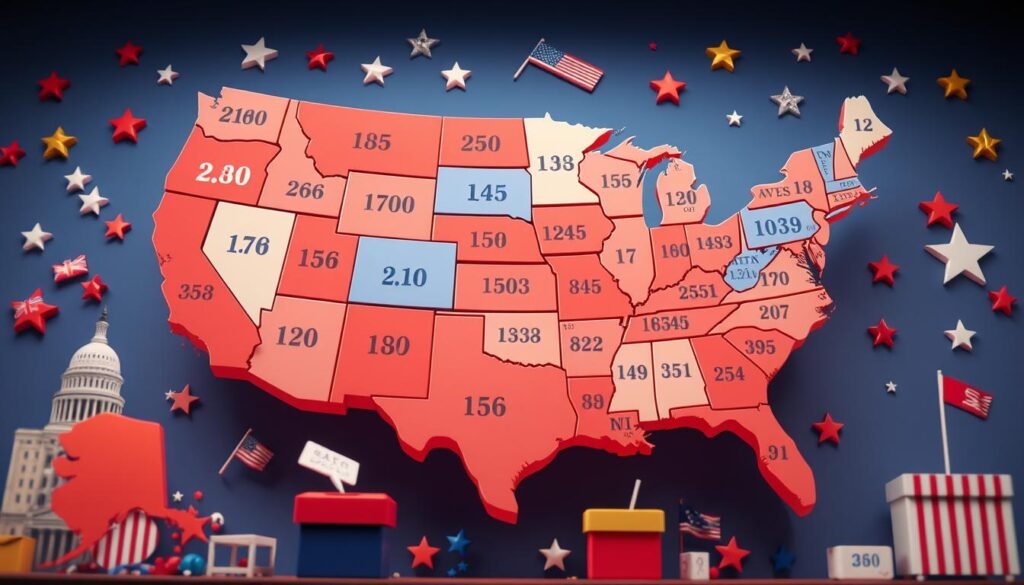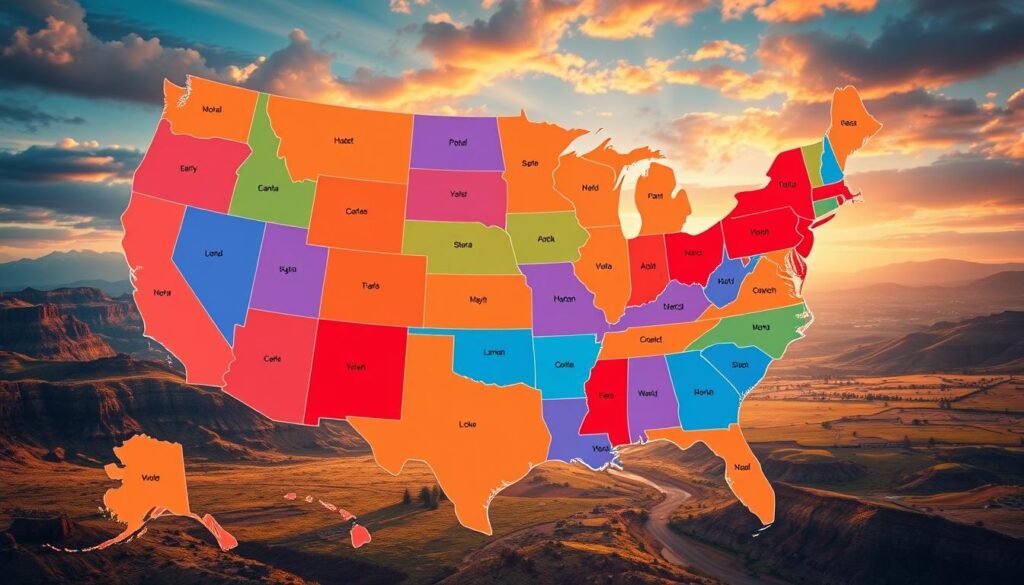In the United States, the electoral process is key to American democracy. It shapes the nation’s future and its role in the world. This guide explores the US election system, from primary campaigns to voting and the outcome’s impact. It covers the unique aspects of American democracy, voting procedures, and the effects of these elections at home and abroad.

Key Takeaways
- The US election system is a cornerstone of American democracy, shaping the nation’s future and global influence.
- This guide provides a comprehensive understanding of the electoral process, including primary campaigns, voting procedures, and the impact of the outcomes.
- Readers will gain insights into the unique features of American democracy, the voting process, and the far-reaching implications of US elections.
- The guide explores the key aspects of the US election system, from the Electoral College to the role of political parties and third-party candidates.
- Readers will learn about the legal framework, cybersecurity measures, and the international perspective on the US election system.
Overview of the American Electoral Process
The United States values its democratic principles. Citizens elect their leaders through a structured process. At the core are the democratic principles that guide the electoral system and ensure fair elections.
The Democratic Foundation of US Elections
The American system is based on universal suffrage. All eligible citizens can vote. This right is protected by the Constitution and laws.
The process aims to be inclusive, transparent, and fair. It lets citizens freely express their will.
Key Electoral Institutions and Bodies
- The Federal Election Commission (FEC) oversees federal campaign finance laws. It ensures fairness and transparency in elections.
- State and local boards manage elections. They handle voter registration, ballot access, and counting votes.
- Nonpartisan groups, like the League of Women Voters, educate and advocate. They strengthen the electoral system.
Timeline of Major Election Events
The election timeline in the United States is clear. It starts with primaries and caucuses, then the general election, and ends with the inauguration. This ensures the people’s will is reflected.
Primaries and caucuses happen early in the year. They let parties choose their nominees. The general election is in November, where citizens vote for their preferred candidate.
The inauguration on January 20th marks the peaceful transfer of power. It begins the new president’s term.
This overview shows the strong democratic principles, important electoral institutions, and clear election timeline. Together, they form the heart of the United States’ democracy.
The Electoral College System Explained
The United States has a special way of choosing its president called the Electoral College. This system is based on the Constitution and is key in deciding who wins the presidency. It often sparks debate and calls for change.
At the core of the Electoral College is how electoral votes are given to each state. The number of votes a state gets is based on its members in Congress. In most states, the candidate who gets the most votes gets all the state’s electoral votes. This is called the winner-take-all system.
Many have criticized the Electoral College over the years. One big issue is when a candidate wins the presidency without getting the most votes nationwide. This is called a faithless elector. It happens when an elector votes against the state’s voters’ choice.

Even with its challenges, the Electoral College is a key part of American democracy. It’s important for citizens to understand it and the debates around it. This helps them make sense of presidential elections.
Primary Elections and Caucuses
The American way of choosing a president is complex. It involves both primary elections and caucuses. These methods help pick the nominees for the big political parties. Closed primaries and open caucuses are key ways parties get their supporters involved and choose their candidates.
Different Types of Primary Systems
Primary elections can be either closed or open. In closed primaries, only party members can vote. This ensures the nominee truly represents the party’s base. Open primaries, on the other hand, let all eligible voters participate, making the field more diverse.
The Role of Political Parties
Political parties are key in the primary process. They organize and run the nomination steps. The final step is the conventions, where delegates from everywhere choose the party’s candidate.
Delegate Selection Process
- Delegates are chosen through primary elections and caucuses, with each state doing it differently.
- The number of delegates each state gets is based on its population and voter turnout. This ensures fair representation.
- Delegates vote for their chosen candidate at the convention. But, they can switch their vote during the process.
Grasping the details of primary elections and caucuses is vital. It helps us understand the American electoral system and the journey to the presidency.
Federal vs State Election Authority
The United States’ electoral system is a mix of federal oversight and state administration. The federal government sets broad guidelines and ensures the electoral process is fair. Meanwhile, state election laws shape the practical details of elections across the country.
The Election Assistance Commission and the Federal Election Commission guide and enforce federal election laws. They handle campaign finance, voter registration, and voting accessibility.
But, state and local governments run the actual administration of elections. Each state has its own election laws, like voter ID rules and early voting options. This lets states adapt to their unique needs.
The mix of federal and state roles in elections is complex and often discussed. The federal government sets the big picture, but states can adjust their election administration practices. This can lead to differences and challenges in ensuring fair voting for all.
“The states are the laboratories of democracy. We have 50 different voting systems in this country, 50 different sets of state election laws.”
– Ari Berman, author and political journalist
The country is still working on electoral integrity and accessibility. The balance between federal oversight and state autonomy is key in the debate about American democracy’s future.

Voter Registration and Requirements
Voter registration is key in the American electoral process. It lets eligible citizens vote. But, the rules and deadlines differ by state, making it complex for voters.
Eligibility Criteria
To vote, you must be a U.S. citizen and live in the state where you’re registering. You also need to be at least 18 years old. Some states ask for ID or a certain amount of time living there.
Registration Deadlines
Registration deadlines change by state. Some need you to register weeks before an election. Others have more flexible rules or let you register on the same day. Knowing your state’s deadline is key to voting.
State-Specific Guidelines
Every state has its own voter registration rules. Things like voter ID laws, registration methods, and voter suppression can affect the process. Check your state’s election website or talk to local officials for the latest info.
“Voter registration is the gateway to political participation, and ensuring that every eligible citizen can register and vote is essential for the health of our democracy.”
Knowing the rules, deadlines, and state-specific guidelines helps voters. This way, they can confidently register and vote. It’s a key part of shaping our communities and country’s future.
Campaign Finance in US Election
In the United States, campaign finance is key to the election landscape. The rules for contributions and spending are complex. Political Action Committees (PACs) and Super PACs are big players in this area.
PACs collect money from people to support or oppose candidates or issues. They follow strict rules on how much they can take and give. Super PACs, on the other hand, can raise and spend unlimited money. But they can’t work directly with the campaigns they support.
The role of money in US elections is a big debate. Some say it’s a way for people to speak out, while others worry it gives too much power to the rich. The Supreme Court’s Citizens United decision has made things even more complicated.
It’s important to understand PACs, Super PACs, and individual donations to get US elections. Looking into campaign finance helps us see how democracy works.
| Entity | Contribution Limits | Expenditure Limits |
|---|---|---|
| PACs | $5,000 per candidate, per election | Subject to limits |
| Super PACs | Unlimited | Unlimited |
| Individuals | $2,900 per candidate, per election | Unlimited |

The influence of campaign finance on the democratic process continues to be a subject of intense debate and scrutiny.
Role of Political Parties and Third-Party Candidates
The United States has long been ruled by the two-party system. The Republican and Democratic parties hold most of the power. This system has shaped our politics and how people vote for decades.
Two-Party Dominance
The Republican and Democratic parties are the main players in US politics. They have strong bases of supporters and lots of resources. The electoral system makes it hard for third-party candidates to break through.
Independent Candidate Impact
Despite the big two, third-party and independent candidates have made a mark. People like Ross Perot, Ralph Nader, and Gary Johnson have changed the game. They may not win, but they can sway the election and make the big parties listen.
| Political Party | Percentage of Popular Vote in 2020 Presidential Election |
|---|---|
| Democratic Party | 51.3% |
| Republican Party | 46.8% |
| Green Party | 0.2% |
The table shows the big two’s dominance in the 2020 election. The Green Party got a tiny fraction of the vote. It shows the hurdles third-party candidates face in the US.
“The two-party system is deeply entrenched in American politics, but third-party and independent candidates can still play a meaningful role in shaping the national discourse and pushing the major parties to address important issues.”
Battleground States and Their Significance
In American elections, a few states are key. These “swing states” or “battleground states” have a big impact. They are places where voters are almost evenly split between Democrats and Republicans.
These states are crucial in deciding who wins the presidency. The Electoral College system gives votes based on the popular vote in each state. So, winning or losing a battleground state can decide a candidate’s fate.
Candidates spend a lot of time and money in these states. They try to win over undecided voters with their message, ads, and field operations. This is why these states are so important.
Some top swing states include Florida, Pennsylvania, Michigan, Wisconsin, Arizona, and Georgia. These states are always closely contested, with small margins of victory. Campaigns watch polls and voter feelings in these places to improve their chances.
| Swing State | 2016 Result | 2020 Result |
|---|---|---|
| Florida | Trump | Trump |
| Pennsylvania | Trump | Biden |
| Michigan | Trump | Biden |
| Wisconsin | Trump | Biden |
| Arizona | Trump | Biden |
| Georgia | Trump | Biden |
The importance of swing states is huge. By focusing on these areas, candidates can use the local politics to their advantage. As politics changes, the role of battleground states will stay key in winning elections.

Media’s Influence on Election Outcomes
In today’s world, the media’s role in shaping public opinion is huge. From old news to new social media, how we get and share info affects voters. Knowing about media bias, fake news, and social media campaigns helps us vote better.
News Coverage Impact
Traditional news media like TV, print, and online are key in telling voters about candidates and issues. But, there’s worry about media bias, where coverage might lean one way or another. This can shape how voters see the election and the choices they have.
Social Media’s Role
Social media has changed how we get and share info during elections. Social media campaigns can spread fake news and media bias fast. This can change voter opinions in big ways. People and groups can share different stories online, some true, some not.
“The power of social media to influence election outcomes cannot be overstated. Voters must be critical consumers of information and verify the sources before forming their opinions.”
Dealing with media and elections is complex. Voters need to be smart about what they read and watch. They should check facts and sources. Also, teaching people to spot fake news and improve media literacy is key to a fair election.
Understanding Presidential Debates
Presidential debates are key in the US election process. They give a stage for debate formats, candidate performances, and policy discussions. These events let voters see how well candidates speak, understand issues, and work together.
Debates usually have moderated Q&A sessions. Candidates share their views on many topics, like the economy and healthcare. They aim to show their leadership, policies, and problem-solving skills.
“Presidential debates are like the Super Bowl of politics. They are a chance for the candidates to directly engage with each other and the American people, and to show who has the vision and leadership to guide the country forward.”
These debates have greatly influenced US elections. Moments like John F. Kennedy’s charm in 1960 or Barack Obama’s skill in 2008 and 2012 debates have changed minds.
Knowing the value of presidential debates helps voters make better choices. These debates let us see candidates’ visions, characters, and readiness to lead.
Election Day Procedures and Protocols
As Election Day gets closer, it’s important to know how voting works. The system has many steps, from different ballot types to counting votes. It makes sure our democracy is strong and fair.
Voting Methods
In the U.S., people can vote in many ways. You can vote in person on Election Day or use early voting and mail-in ballots. This makes voting easy for everyone.
- In-Person Voting: On Election Day, voters go to their polling stations. They get help from election officials and poll workers.
- Early Voting: Many states let you vote early. You can do this over several weeks before Election Day.
- Mail-In Ballots: With the pandemic, more people are using mail-in ballots. This way, you can vote without going to the polls.
Poll Watching
Poll watchers help keep the voting process fair. They are from political parties or civic groups. They watch how votes are counted to make sure everything is right.
Vote Counting Process
Counting votes is a detailed process. It involves election officials, volunteers, and strict rules. From counting in-person ballots to checking mail-in votes, the goal is to count every vote correctly.
“The right of citizens of the United States to vote shall not be denied or abridged by the United States or by any State on account of race, color, or previous condition of servitude.”
– 15th Amendment to the U.S. Constitution
Post-Election Process and Transition
After Election Day, the post-election process starts. It includes confirming results, handling recounts or legal issues, and the peaceful handover to the new team. Concession speeches and recounts are key to a smooth transition, keeping democracy alive in America.
The journey after an election is complex. First, election officials in each state count and check the votes. This step, called the “canvass,” makes sure the results are right and fair.
Close results might lead to recounts. These reviews check every vote to make sure they count. Both sides watch closely to keep things fair.
After results are confirmed, the outgoing president usually gives a concession speech. This act shows respect for the people’s choice and promises a smooth handover. It’s a sign of democracy’s strength in America.
The transition period, from Election Day to Inauguration Day, is crucial. It’s when the new team gets ready to take over. They learn about the job, set up the new administration, and plan the inauguration. This ensures the new president is ready to serve the people well.
| Key Events | Timeline |
|---|---|
| Canvass and Certification of Results | Within weeks of Election Day |
| Recounts (if applicable) | Varies by state, often within a few weeks |
| Concession Speeches | Usually within days of Election Day |
| Presidential Transition | Approximately 10 weeks, from Election Day to Inauguration Day |
The post-election process and transition are vital to American democracy. They ensure power is transferred peacefully and smoothly. By following these steps, the U.S. shows its dedication to democratic values since its start.
Technology and Security in Modern Elections
Technology plays a big role in elections today. Keeping electronic voting systems safe is key. We need strong cybersecurity to stop hacking and protect our democracy.
Cybersecurity Measures
Election officials and tech experts are working hard to keep voting systems safe. They’ve set up many security steps, like:
- Strong security for voter data to keep it safe from hackers
- Encryption and access controls for voting machines
- Plans to quickly fix any security issues
- Regular checks to find and fix weak spots
Voting Machine Systems
Electronic voting machines have raised concerns about election hacking. To fix this, officials have made voting machines more secure. They’ve also added steps to make voting more open and fair, such as:
- Strict rules for handling voting machines
- Voter-verifiable paper audit trails for each vote
- Regular checks to make sure votes are counted right
- Investing in safer electronic voting tech
Keeping voter data safe and elections secure is an ongoing battle. It takes teamwork between election officials, tech experts, and the public. With strong security steps, we can protect our elections.
| Cybersecurity Measure | Description |
|---|---|
| Voter Registration and Data Security | Robust protocols to protect voter information and prevent unauthorized access |
| Voting Machine Security | Secure storage, transportation, and operation of voting machines to prevent tampering |
| Auditing and Verification | Regular audits and verifications to ensure the accuracy and reliability of election results |
| Incident Response | Comprehensive plans to quickly identify and address any security breaches or anomalies |
Legal Framework of US Elections
The legal landscape of US elections is complex. It’s shaped by key laws, Supreme Court decisions, and many lawsuits. At its core is the Voting Rights Act, a law that greatly impacts voting rights and access.
The Voting Rights Act was passed in 1965. It aimed to protect the voting rights of racial minorities. Over time, the Supreme Court has made many decisions about this law. These decisions have changed how elections are run and the rules that govern them.
Election-related lawsuits also play a big role. They deal with issues like voter ID, gerrymandering, ballot access, and vote-counting. The results of these lawsuits can change how elections are run, affecting their integrity and rules.
| Legislation | Supreme Court Decisions | Election Lawsuits |
|---|---|---|
| Voting Rights Act (1965) | Shelby County v. Holder (2013) | Brnovich v. Democratic National Committee (2021) |
| Crawford v. Marion County Election Board (2008) | Husted v. A. Philip Randolph Institute (2018) | |
| Rucho v. Common Cause (2019) | North Carolina v. Covington (2018) |
The legal framework of US elections is always changing. It’s influenced by laws, Supreme Court decisions, and lawsuits. Understanding this complex system is key to navigating American elections and ensuring democracy works well.
International Perspective on US Election System
The US electoral system is a big deal worldwide. As the world’s biggest economy and a top democracy, how fair US elections are matters a lot. Countries watch US elections closely to learn from them.
Global Impact
US election results can change a lot. They affect global trade, security, and how countries talk to each other. The world pays attention to who wins in the US because it can change what happens globally.
The peaceful change in power in the US is seen as a sign of its strong democracy. This is something the world looks up to.
Comparative Analysis
Many praise the US for its democratic values. But, some international observers have concerns. For example, the Electoral College system is debated. It lets a candidate win the presidency without getting the most votes.
Also, how money affects US politics is compared to other countries. The US has less strict rules on political donations. This is something other democracies have different rules for.
FAQ
What is the democratic foundation of US elections?
The US election system is based on democracy. Citizens have the right to vote and choose their leaders. Laws like the Voting Rights Act ensure free and fair elections.
What are the key electoral institutions and bodies in the US?
The Federal Election Commission (FEC) oversees elections. State and local governments also play a big role. They manage elections through their boards and secretaries of state.
How does the Electoral College system work in the US?
The Electoral College is a unique part of US elections. Each state gets a number of electors based on its Congress members. The winner of the popular vote in a state gets all its electoral votes, except in some cases.
What is the difference between primary elections and caucuses?
Primary elections and caucuses help pick presidential nominees. Primaries are state-run elections. Caucuses are local gatherings where members vote on candidates.
How is election authority divided between federal and state governments?
The Constitution gives states the main job of running elections. The federal government oversees and ensures laws like the Voting Rights Act are followed. This can lead to different election rules in states.
What are the voter registration requirements in the US?
Voter registration rules vary by state. You usually need to give personal info like name and address. Some states also require ID or have deadlines. Making sure eligible citizens can vote is key.
How does campaign finance work in US elections?
Campaign finance lets individuals, PACs, and Super PACs donate. Rules have changed over time. Debates continue about money’s role in elections and its influence.
What is the impact of third-party and independent candidates in US elections?
Third-party and independent candidates can be important, especially in close races. They can shape policy discussions and sway outcomes.
Which states are considered battleground or swing states, and why are they important?
Battleground states are close between the two major parties. They’re crucial in the presidential election. Campaigns focus on these states to win the Electoral College.
How do the media and social media influence US election outcomes?
Media and social media can greatly affect public opinion and voting. Debates include media bias, misinformation, and social media campaigns.
What is the role of presidential debates in the election process?
Presidential debates let candidates share their views and influence voters. The debate format and moderators can shape the election’s outcome.
What are the key procedures and protocols on Election Day?
Election Day involves voting methods, poll watchers, and vote counting. Ensuring these processes are secure is vital for trust in the system.
What happens after the election results are announced?
After results, the process includes confirming votes and possibly recounts. The peaceful transfer of power and presidential transition are also key steps.
How is technology and cybersecurity addressed in modern US elections?
Technology, like electronic voting, raises cybersecurity concerns. Efforts to protect elections are ongoing at all levels.
What is the legal framework that governs US elections?
The Constitution, federal laws, and court rulings form the legal basis for US elections. They cover voter eligibility, campaign finance, and dispute resolution.
How do international observers and global stakeholders view the US election system?
The US election system is closely watched globally. Concerns include its impact on world affairs and comparisons with other democracies. International observers monitor fairness and transparency.
2 thoughts on “Complete Guide to Understanding the US Election”